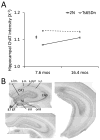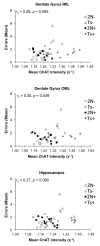Effects of Maternal Choline Supplementation on the Septohippocampal Cholinergic System in the Ts65Dn Mouse Model of Down Syndrome
- PMID: 26391045
- PMCID: PMC4733527
- DOI: 10.2174/1567205012666150921100515
Effects of Maternal Choline Supplementation on the Septohippocampal Cholinergic System in the Ts65Dn Mouse Model of Down Syndrome
Abstract
Down syndrome (DS), caused by trisomy of chromosome 21, is marked by intellectual disability (ID) and early onset of Alzheimer's disease (AD) neuropathology including hippocampal cholinergic projection system degeneration. Here we determined the effects of age and maternal choline supplementation (MCS) on hippocampal cholinergic deficits in Ts65Dn mice compared to 2N mice sacrificed at 6-8 and 14-18 months of age. Ts65Dn mice and disomic (2N) littermates sacrificed at ages 6-8 and 14-18 mos were used for an aging study and Ts65Dn and 2N mice derived from Ts65Dn dams were maintained on either a choline-supplemented or a choline-controlled diet (conception to weaning) and examined at 14-18 mos for MCS studies. In the latter, mice were behaviorally tested on the radial arm Morris water maze (RAWM) and hippocampal tissue was examined for intensity of choline acetyltransferase (ChAT) immunoreactivity. Hippocampal ChAT activity was evaluated in a separate cohort. ChAT-positive fiber innervation was significantly higher in the hippocampus and dentate gyrus in Ts65Dn mice compared with 2N mice, independent of age or maternal diet. Similarly, hippocampal ChAT activity was significantly elevated in Ts65Dn mice compared to 2N mice, independent of maternal diet. A significant increase with age was seen in hippocampal cholinergic innervation of 2N mice, but not Ts65Dn mice. Degree of ChAT intensity correlated negatively with spatial memory ability in unsupplemented 2N and Ts65Dn mice, but positively in MCS 2N mice. The increased innervation produced by MCS appears to improve hippocampal function, making this a therapy that may be exploited for future translational approaches in human DS.
Conflict of interest statement
The authors have no conflicts of interest to disclose.
Figures







References
-
- Määttä T, Tervo-Määttä T, Taanila A, Kaski M, Iivanainen M. Mental health, behaviour and intellectual abilities of people with Down syndrome. Downs Syndr Res Pract. 2006;11(1):37–43. - PubMed
-
- Epstein CJ. Epilogue: toward the twenty-first century with Down syndrome--a personal view of how far we have come and of how far we can reasonably expect to go. Prog Clin Biol Res. 1995;393:241–6. - PubMed
-
- Sendera TJ, Ma SY, Jaffar S, Kozlowski PB, Kordower JH, Mawal Y, et al. Reduction in TrkA-immunoreactive neurons is not associated with an overexpression of galaninergic fibers within the nucleus basalis in Down’s syndrome. J Neurochem. 2000;74(3):1185–96. - PubMed
-
- Mesulam MM, Mufson EJ, Wainer BH, Levey AI. Central cholinergic pathways in the rat: an overview based on an alternative nomenclature (Ch1–Ch6) Neuroscience. 1983;10(4):1185–201. - PubMed
Publication types
MeSH terms
Substances
Grants and funding
LinkOut - more resources
Full Text Sources
Medical

